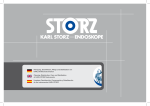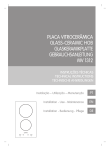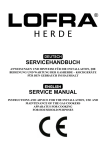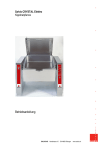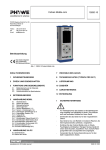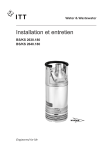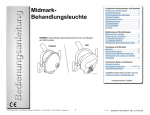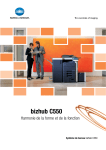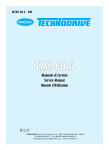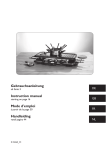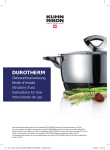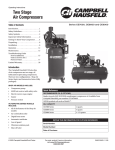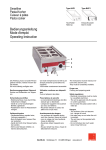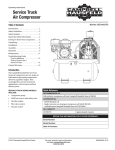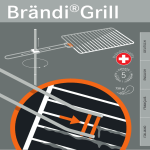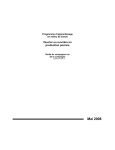Download SYSTEM 900
Transcript
SYSTEM 900 Installations- und Bedienungsanleitung Manuale d'installazione e d'uso Notice d'emploi et d'entretien Instructions for Installation and Use ELEKTRO GLASKERAMIKHERD CUCINA IN VETROCERAMICA ELETTRICA CUISINIERE VITROCERAMIQUE ELECTRIQUE ELECTRIC GLASS-CERAMIC RANGE 5134364245 Typen: Modelli: Models: Modèles: CH/45 CH/45-T CH/90 CH/90-T Ausgabedatum: 07/07 Data d'emissione: 07/07 Date d'emission: 07/07 Date of issue: 07/07 System 900 - Elektroherde mit Glaskeramikplatte CH INHALTSVERZEICHNIS 1. 1.1 1.2 1.3 ALLGEMEINE KONTROLLE ................................................................................................ 3 VERPACKUNG UND ZUBEHÖR ........................................................................................... 3 ELEKTROBEDINGUNGEN VOR ORT .................................................................................. 3 GERÄTEEINSTELLUNG ........................................................................................................ 3 2. 2.1 2.2 TECHNISCHE DATEN ........................................................................................................... 3 TYPENBESCHREIBUNG ....................................................................................................... 3 GEWICHT ............................................................................................................................... 4 3. AUFSTELLUNG ..................................................................................................................... 4 4. VORSCHRIFTEN ................................................................................................................... 5 5. INSTALLATION ..................................................................................................................... 5 5.1 ELEKTRO ANSCHLUSS ........................................................................................................ 5 5.1.1 Leistungsoptimierungsanlage ................................................................................................ 5 5.1.2 Anschluss an FI-Schalter (Fehlerstromschutzschalter) ...................................................... 6 6. 6.1 FUNKTIONSKONTROLLE .................................................................................................... 6 MÖGLICHE FEHLERURSACHEN UND DEREN BEHEBUNG ............................................ 6 7. 7.1 7.2 7.3 7.4 7.5 7.6 BEDIENUNG .......................................................................................................................... 7 INBETRIEBNAHME ................................................................................................................. 7 WARTUNG .............................................................................................................................. 7 PFLEGE UND REINIGUNG .................................................................................................... 7 AUSWECHSELN DER GLASKERAMIKPLATTE .................................................................. 9 AUSWECHSELN EINES KOCHPLATTEN-HEIZKÖRPERS ............................................... 9 VERHALTEN BEI STÖRUNGEN ........................................................................................... 9 Anlagen an die Bedienungsanleitung: (separat mit Artikel-Nr.5134365143) - Technische Daten Nummer - Elektro Schaltpläne - Ersatzteillisten 2 07/07 System 900 - Elektroherde mit Glaskeramikplatte CH 1. ALLGEMEINE KONTROLLE ======================= 1.1 VERPACKUNG UND ZUBEHÖR Die Verpackung ist äußerlich auf Beschädigung zu überprüfen. Bei Beschädigung, die Reklamationen direkt an die Spedition richten. Gerät auspacken und Zubehör anhand der mitgelieferten Liste kontrollieren. Der Hersteller haftet nicht für Personen- und Sachschäden infolge Installationsfehlern oder unsachgemäßer Benutzung der Geräte. 1.2 ELEKTROBEDINGUNGEN VOR ORT Die notwendigen technischen Daten über die Spannung und die Frequenz erhalten Sie von Ihrem Elektroversorgungsunternehmen (EVU). 1.3 GERÄTEEINSTELLUNG Das Gerät wird werkseitig für die auf dem Typenschild vermerkte Betriebsspannung eingestellt (Standardeinstellung 400 V 3 N AC) eingestellt. Das Gerät ist nur für den Anschluß an eine fest verlegte Netzanschlußleitung nach EN 60335 vorgesehen. 2. TECHNISCHE DATEN ================== Ausführung: Herdabdeckung Wandungen Kochmulden Rahmen 2.1 : : : : Chromnickelstahl (Werkstoffnummer 1.4301) Chromnickelstahl (Werkstoffnummer 1.4301) Chromnickelstahl (Werkstoffnummer 1.4301) Chromstahl (Werkstoffnummer 1.4016) TYPENBESCHREIBUNG CH/45 2 Heizkörper 2 Zonen zu je 4,0 kW Gesamt Nennaufnahme Nennspannung Maximaler Phasenstrom Nennfrequenz CH/45-T 8,0 kW 400 V 3 N AC 17,3 A 50 ÷ 60 Hz 2 Heizkörper 2 Zonen zu je 4,0 kW mit Topferkennung Gesamt Nennaufnahme 8,0 kW Nennspannung 400 V 3 N AC Maximaler Phasenstrom 17,3 A Nennfrequenz 50 ÷ 60 Hz 3 07/07 System 900 - Elektroherde mit Glaskeramikplatte CH CH/90; CH/90-BF CH/90-T CH/90-T-BF 2.2 3. 4 Heizkörper 4 Zonen zu je 4,0 kW Gesamt Nennaufnahme Nennspannung Maximaler Phasenstrom Nennfrequenz 16,0 kW 400 V 3 N AC 17,3 A 50 ÷ 60 Hz 4 Heizkörper 4 Zonen zu je 4,0 kW mit Topferkennung Gesamt Nennaufnahme 16,0 kW Nennspannung 400 V 3 N AC Maximaler Phasenstrom 17,3 A Nennfrequenz 50 ÷ 60 Hz GEWICHT CH/45 Netto: 63 kg CH/45-T Netto: 63 kg CH/90 Netto: kg CH/90-T Netto: kg Mit Verpackung: 70 kg Mit Verpackung: 70 kg Mit Verpackung: kg Mit Verpackung: kg AUFSTELLUNG ============= Vor der Aufstellung die Plastik-Folie vom Gerät abziehen und Klebstoffreste mit Edelstahlpfleger entfernen. Das Gerät muss fest und waagrecht stehen. Mit der Wasserwaage einstellen! Korrekturen können durch Verdrehen der Füße bei Tischgeräten oder Standgeräten bzw. durch Verdrehen der Justierschrauben bei bodenfreier Montage erreicht werden. Bitte darauf achten, daß die Wärmeabstrahlung keine schädigende Auswirkung auf die Umgebung hat. Bei Aufstellung dieses Gerätes in unmittelbarer Nähe von Wänden, Trennwänden, Küchenmöbel, dekorativen Verkleidungen usw. wird empfohlen, daß diese aus nichtbrennbarem Material gefertigt sind, andernfalls müssen sie mit geeignetem, nichtbrennbarem Material verkleidet werden. Die genaueste Beachtung der Vorschriften des Brandschutzes muß sichergestellt werden. HINWEIS MODULBAUWEISE: Unsere Modul Geräte sind zur Kombination mit geprüften Unterbauten wie z.B. Elektro Modul-Brat/Backofen und Elektro-Wärmeschrank sowie als Einzelmodul-Verwendung vom Hersteller vorgesehen. Bei Einzelmodul-Verwendung liegt dann entweder eine Tischausführung oder ein Anschluss an eine Installationswand oder Zusammenbau mit einem geeigneten neutralen Unterbau vor. Die Geräte CH/45T und CH/90T dürfen nur mit einem offenen Unterbau betrieben werden. Bei anderer Anordnung ist darauf zu achten, dass eine schädliche gegenseitige Beeinflussung vermieden wird (Hersteller konsultieren). ACHTUNG: Bei Einzelaufstellung müssen diese Geräte befestigt werden. Die hierzu erforderlichen Befestigungswinkel können direkt beim Hersteller bestellt werden (Siehe Ersatzteilliste 9). 4 07/07 System 900 - Elektroherde mit Glaskeramikplatte CH WICHTIG: Die Modulzusammenstellung erfolgt grundsätzlich durch vom Hersteller autorisiertes Personal. 4. VORSCHRIFTEN ============== Bei der Aufstellung sind folgende Vorschriften zu beachten: - Einschlägige EN 60335 Vorschriften - Einschlägige Rechtsverordnungen; - Landesbauordnungen und Feuerungsverordnungen ; - Bestimmungen des Elektroversorgungsunternehmens (EVU); - Einschlägige Unfallverhütungs-Vorschriften; 5. INSTALLATION ============= Aufstellungs-, Installations- und Wartungsarbeiten dürfen nur unter Beachtung der o.g. Vorschriften durchgeführt werden. Bei der Aufstellung sind die Angaben des Typenschildes, des Schaltplanes, sowie die einschlägigen bauaufsichtlichen und gewerbeaufsichtlichen Bestimmungen zu beachten. Etwaige Elektro-Bestimmungen und Unfallverhütungsvorschriften der Berufgenossenschaften sind ebenfalls zu berücksichtigen. 5.1 ELEKTROANSCHLUSS Die Kabeleinführung befindet sich an der linken Geräterückwand. Die Netzanschlussklemme befindet sich hinter der Schaltblende. Der Anschluss an das Stromnetz darf nur von einem konzessionierten Elektroinstallateur durchgeführt werden. Als Anschlußleitung ist eine Mantelleitung des Typs NYM unter Berücksichtigung des erforderlichen Nennquerschnittes zu verwenden. Neben der Netzanschlussklemme befindet sich eine eigene Klemme zum Anschluß einer Potentialausgleichsleitung. Diese ist neben dem Schutzleiter unbedingt erforderlich. Die Wirkung des Potentialausgleichssystems muss geprüft werden. Durch den Installateur ist vor dem Gerät eine Vorrichtung zur allpoligen Abtrennung vom Netz mit mindestens 3 mm Kontaktöffnung anzubringen (z.B. Sicherung, Schütz, Trennschalter). Das Gerät muss auf alle Fälle geerdet werden. 5.1.1 Leistungsoptimierungsanlage Wenn das Gerät an eine Leistungsoptimierungsanlage angeschlossen wird, muss folgendes beachtet werden: Achtung: Beim Anschluss an eine Leistungsoptimierungsanlage sind die Drahtbrücken XN.1 und Y-L1.1 zu entfernen. An die Klemme "L1.1" ist eine Phase und an die Klemme "N.1" der Nulleiter der Leistungsoptimierungsanlage anzuschliessen. An der Klemme "A" wird die Meldung "Gerät ein" (230 V) angegeben (siehe Elektro Schaltplan). 5 07/07 System 900 - Elektroherde mit Glaskeramikplatte CH 5.1.2 Anschluss an FI-Schalter (Fehlerstromschutzschalter) Bei Verwendung eines FI-Fehlerstromschutzschalters gilt folgendes: - Laut EN 60335 darf der Ableitstrom bei Großküchengeräten je angeschlossenem kW Leistung 1 mA ohne Maximumbegrenzung betragen. Dabei ist ferner zu beachten, daß alle marktüblichen FI-Schalter eine Toleranz des Auslösestroms von minus 50 % haben und somit ist ein geeigneter FI-Schalter auszuwählen. - Nur 1 Gerät pro FI-Schalter anschliessen. - Im Einzelfall ist es möglich, daß ein Gerät nach längerer Lagerung, Außerbetriebnahme oder Neuinstallation beim Betrieb den FI-Schalter auslöst. Die Ursache liegt meist in einer feucht gewordenen Betriebsisolierung. Abhilfe schafft ein Trockenheizen des Gerätes unter kurzzeitiger Umgehung des FI- Schalters. 6. FUNKTIONSKONTROLLE ===================== - GERÄTss ENTSPRECHEND DER BEDIENUNGSANLEITUNG IN BETRIEB NEHMEN; - HEIZUNGSLEISTUNG UND SCHALTVERHALTEN DER THERMOSTATE KONTROLLIEREN; - EIN- AUSSCHALTEN KONTROLLEUCHTE KONTROLLIEREN; - BENUTZER MIT DER GERÄTEBEDIENUNG VERTRAUT MACHEN UND ANLEITUNG ÜBERGEBEN; - WARTUNGSVERTRAG EMPFEHLEN. 6.1 MÖGLICHE FEHLERURSACHEN UND DEREN BEHEBUNG Störungen 1 Gerät lässt sich nicht betriebsbereit schalten Ursachen a) Keine Spannung a) Hauptschalter, Sicherung usw. einschalten a) Energieregler bzw. Schalter defekt Heizkörper defekt Topferkennung defekt a) d) Bedienungsfehler! Beim Einschalten des Gerätes Topf auf der Kochzone d) Energieregler bzw. Schalter erneuern Heizkörper auswechseln Topferkennungselektronik erneuern Topf von der Kochzone entfernen, dann Kochzone aus- und wieder einschalten und Topf wieder positionieren a) b) Heizkörper defekt Bedienungsfehler! Energieregler falsch eingestellt a) b) Heizkörperaustauschen Energieregler richtig einstellen a) Kontrollleuchte defekt a) Kontrollleuchte auswechseln b) c) 2 Eine Heizzone wird nicht heiss 3 Ungenügende Heizleistung einer Heizzone 4 Kontrollleuchte leuchtet nicht Behebung b) c) WICHTIG: Beim Einschalten des Gerätes CH/...-T darf sich kein Topf auf der Glaskeramikplatte befinden. Andernfalls muß das Gerät noch einmal ausgeschaltet und der Topf entfernt werden. 6 07/07 System 900 - Elektroherde mit Glaskeramikplatte CH 7. BEDIENUNG =========== Das Gerät ist für gewerbliche Zwecke vorgesehen und darf nur von Fachkräften bedient werden. WICHTIG: Das Gerät ist nur für den beaufsichtigten Betrieb vorgesehen. Nach längerer Betriebsunterbrechung sollte das Gerät von einem Fachmann überprüft werden. 7.1 INBETRIEBNAHME Das Glaskeramikfeld ist in 2 Heizzonen unterteilt, welche getrennt thermostatisch von 70° bis 450° C stufenlos regelbar sind. Durch die thermostatische Regelung wird die Energiezufuhr beim Erreichen der eingestellten Temperatur abgeschalten. ACHTUNG: Das Gerät darf nicht mit gesprungener Glaskeramikplatte betrieben werden. Die Glaskeramikplatte darf nicht als Abstellfläche verwendet werden. Auf die Glaskeramikplatte dürfen keine Alufolien, Plastiktücher oder Ähnliches gelegt werden. 7.2 WARTUNG Vor Reparaturen oder sonstigen Wartungsarbeiten muss das Gerät durch die vorgeschaltete Vorrichtung allpolig vom Stromnetz abgetrennt werden. Es ist ratsam, das Gerät jährlich von einem Fachmann auf seine einwandfreie Funktion überprüfen zu lassen. 7.3 PFLEGE UND REINIGUNG Eine gründliche und tägliche Reinigung der Geräte verhindert Funktionsstörungen und Ansetzen von harten Fettoberflächen. Die Geräte dürfen keinesfalls direkt mit Wasser abgespritzt oder mit Hochdruckreiniger gereinigt werden. Die Geräte sind mit handelsüblichen Reinigungsmitteln zu reinigen und mit klarem Wasser nachzuspülen. Stahlwolle oder Ähnliches darf in keinem Fall zur Reinigung verwendet werden. Vor dem Reinigen grundsätzlich das Gerät abschalten. Reinigen Sie das Kochfeld nach jedem Gebrauch. Zum Abwischen genügt ein feuchter Schwamm oder ein feuchtes Tuch. Bei starker Verschmutzung verwenden Sie die im Fachhandel erhältlichen Schaber und Reiniger für Glaskeramikkochplatten. Keine körnigen Putzmittel, scharfe Topfkratzer, Verdünnungs-, Lösungs- oder scharfe Reinigungsmittel verwenden, denn sie zerstören bzw. beschädigen die Glaskeramikplatte. Entfernen Sie Kalkflecken, Zucker, Zitronensäure so schnell wie möglich von der Glaskeramikplatte. Sie können sich einbrennen und dadurch die Platte beschädigen. Achten Sie darauf, daß Gewürzkörner, Sand vom Gemüseputzen und Ähnliches sorgfältig von der Glaskeramikplatte entfernt werden, denn sie zerkratzen beim Verschieben der Töpfe die Oberfläche. Achten Sie darauf, dass keine spitzen oder scharfkantigen Gegenstände auf die Glaskeramikplatte fallen oder aufgeschlagen werden. Dies könnte zum Glasbruch führen. 7 07/07 System 900 - Elektroherde mit Glaskeramikplatte CH Die für Grossküchengeräte eingesetzten Edelstähle sind hochwertige und bewährte Materialien. Sie sind aufgrund der Summe ihrer positiven Eigenschaften ideale Werkstoffe für den Lebensmittelbereich. Der Grund für die Korrosionsbeständigkeit nichtrostender Edelstähle ist eine Passivschicht, die sich bei Zutritt von Sauerstoff an der Metalloberfläche bildet. Hierzu reicht der in der Luft vorhandene Sauerstoff aus. Wird diese Passivschicht durch mechanische Einwirkungen verletzt oder chemisch zerstört und zusätzlich die Neubildung der Passivschicht verhindert (Sauerstoffabschluß), so kann es auch bei rostfreiem Edelstahl zu Korrosionsschäden kommen. Beim Umgang mit Geräten aus "Edelstahl rostfrei" sind deshalb folgende Grundsätze zu beachten: - Die Oberfläche von Edelstahl ist immer sauber und für die Luft zugänglich zu halten. Unter Kalk, Eiweiß- und Stärke- oder sonstigen Schichten kann durch fehlenden Sauerstoff Korrosion entstehen. - Zum Entkalken keine salz- oder schwefelsäurehaltigen Präparate verwenden. Der Handel bietet hierzu geeignete Kalklöser an, aber auch verdünnte Essigsäure läßt sich einsetzen. - Zum Reinigen von Edelstahlgeräten am besten nur spezielle Edelstahlreinigungsmittel verwenden. Für die Reinigung zwischendurch ist auch eine schwache Spülmittellauge geeignet. Nach dem Reinigen Geräte mit klarem Wasser abwischen und trockenreiben. - Scheuerpulver jeglicher Art sowie chlorhaltige oder sonstige bleichende Reinigungsmittel sind zu vermeiden. - Bei verschliessbarem Edelstahlgeräten im unbenutzten Zustand Deckel immer geöffnet halten, damit ungehindert Frischluft an die Metalloberfläche gelangt. - Rostfreier Stahl darf nicht längere Zeit mit konzentrierten Säuren - z.B. Essigessenz oder Würzkonzentrat wie Kochsalzlösung, Senf, Würzmischungen - in Kontakt kommen. Bei entsprechender Temperatur und Konzentration können diese Mittel die Passivschicht chemisch zerstören. Deshalb Kontaktflächen sofort mit klarem Wasser spülen. - Ungünstig ist es, Kochkessel aus Edelstahl ausschließlich zum Kochen von Speisen in Salzwasser (Salzkartoffeln, Reis, Nudeln) einzusetzen. Ab und zu sollten auch fetthaltige Suppen, Sauerkraut und Gemüse darin zubereitet werden. Dies hilft Korrosionsschäden zu vermeiden. - Nach dem Kochen von Speisen in Salzwasser, das Gerät gründlich mit Frischwasser spülen. Antrocknende Kochwasserreste bilden nämlich Salzlösungen von hoher Konzentration, die punktuelle Korrosion verursachen können. - Um den sogenannten Fremdrost zu vermeiden, ist jegliche längere Berührung von Edelstahl mit Eisen oder normalem Stahl zu unterbinden. Kommt nichtrostender Stahl mit Eisen (z.B. Stahlwolle, Eisenspäne, eisenhaltiges Wasser verursacht durch rostende Leitungen) in Kontakt, entstehen winzige chemisch aktive Teile, die die Ursache für selbständig weitergehende Korrosion sind. - Eventuell auftretende Fremdroststellen sofort mit mildem Scheuermittel (ausnahmsweise) oder feinem Schleifpapier beseitigen. Starke Roststellen lassen sich mit 5 %-iger Oxalsäure entfernen. 8 07/07 System 900 - Elektroherde mit Glaskeramikplatte CH 7.4 AUSWECHSELN DER GLASKERAMIKPLATTE - Schaltblende abschrauben; - Rahmen-Befestigungsschrauben lösen und Rahmen nach oben abnehmen; - Neuen Rahmen mit Glaskeramikplatte in umgekehrter Reihenfolge montieren. 7.5 AUSWECHSELN EINES KOCHPLATTEN-HEIZKÖRPERS - Schaltblende abschrauben; - Befestigung des Glaskeramikrahmens lösen und Rahmen nach oben abnehmen; - Anschlusskabel vom defekten Heizkörper lösen und Heizkörper nach oben abnehmen; - Montage erfolgt in umgekehrter Reihenfolge. 7.6 VERHALTEN BEI STÖRUNGEN Bei Störungen ist das Gerät ausser Betrieb zu setzen und allpolig vom Netz abzutrennen. Wartungsdienst rufen! Die Herstellerfirma lehnt jede Verantwortung für mögliche, durch Druckfehler entstandene Ungenauigkeiten in dieser Anleitung ab. Sie behält sich das Recht vor, an den Produkten für notwendig oder nützlich erachtete Änderungen durchzuführen, die deren wesentliche Eigenschaften nicht beeinträchtigen. 9 07/07 System 900 - Cucine in vetroceramica elettriche CH INDICE 1. 1.1 1.2 1.3 CONTROLLO GENERALE ................................................................................................ 11 IMBALLO ED ACCESSORI ................................................................................................ 11 CONDIZIONI DI ALLACCIAMENTO ELETTRICO SUL LUOGO D'INSTALLAZIONE 11 TARATURA DELL'APPARECCHIATURA ......................................................................... 11 2. 2.1 2.2 DATI TECNICI ...................................................................................................................... 11 DESCRIZIONE MODELLI ................................................................................................... 11 PESO .................................................................................................................................... 12 3. MONTAGGIO ....................................................................................................................... 12 4. PRESCRIZIONI .................................................................................................................... 13 5. 5.1 5.1.1 5.1.2 INSTALLAZIONE ................................................................................................................. 13 COLLEGAMENTO ELETTRICO ....................................................................................... 13 Collegamento ad un impianto di ottimizzazione di potenza ...................................... 13 Collegamento ad un interruttore di sicurezza per correnti di guasto ..................... 14 6. 6.1 CONTROLLO DI FUNZIONAMENTO ............................................................................... 14 POSSIBILI CAUSE DI GUASTI E LORO RISOLUZIONE ............................................... 14 7. 7.1 7.2 7.3 7.4 7.5 7.6 MODALITÀ D'USO .............................................................................................................. 15 MESSA IN FUNZIONE ........................................................................................................ 15 MANUTENZIONE ................................................................................................................ 15 MANUTENZIONE E PULIZIA .............................................................................................. 15 SOSTITUZIONE DELLA PIASTRA VETROCERAMICA .................................................. 17 SOSTITUZIONE DELLA RESISTENZA DELLA PIASTRA .............................................. 17 COMPORTAMENTO IN CASO DI GUASTO .................................................................... 17 Allegato al manuale d'installazione e d'uso (codice nr. 5134365143) - Dati tecnici - Schemi elettrici - Lista parti di ricambio 10 07/07 System 900 - Cucine in vetroceramica elettriche CH 1. CONTROLLO GENERALE ===================== 1.1 IMBALLO ED ACCESSORI L'imballo dovrà essere controllato in merito ad evidenti danneggiamenti esteriori. In caso di danni evidenti rivolgere il reclamo direttamente alla ditta trasportatrice. Togliere l'imballo dell'apparecchiatura e controllare gli accessori in base all'elenco accluso. Il produttore non risponde di danni a persone o cose causati da errori d'installazione o da utilizzo inadeguato delle apparecchiature. 1.2 CONDIZIONI DI ALLACCIAMENTO ELETTRICO SUL LUOGO D'INSTALLAZIONE I dati tecnici necessari sulla tensione elettrica e sulla frequenza vengono forniti dall'azienda erogatrice competente. 1.3 TARATURA DELL'APPARECCHIATURA L'apparecchio sarà regolato dall'azienda in base alla tensione di esercizio annotata sulla targhetta (installazione standard 400 V 3 N AC). L'apparecchio è previsto solo per l'allacciamento ad un collegamento fisso alla rete secondo le norme EN 60335. 2. DATI TECNICI ============ Esecuzione: Piano di cottura Pareti Vano cottura Telaio 2.1 : : : : acciaio acciaio acciaio acciaio inox inox inox inox (AISI (AISI (AISI (AISI 304) 304) 304) 430) DESCRIZIONE MODELLI CH/45 2 resistenze 2 zone da 4,0 kW Potenza nominale totale Tensione nominale Tensione di corrente massimale Frequenza nominale CH/45-T 8,0 kW 400 V 3 N AC 17,3 A 50 ÷ 60 Hz 2 resistenze 2 zone da 4,0 kW con riconoscimento pentola Potenza nominale totale 8,0 kW Tensione nominale 400 V 3 N AC Tensione di corrente massimale 17,3 A Frequenza nominale 50 ÷ 60 Hz 11 07/07 System 900 - Cucine in vetroceramica elettriche CH CH/90; CH/90-BF 4 resistenze 4 zone da 4,0 kW Potenza nominale totale Tensione nominale Tensione di corrente massimale Frequenza nominale CH/90-T CH/90-T-BF 2.2 3. PESO CH/45 CH/45-T CH/90 CH/90-T 16,0 kW 400 V 3 N AC 17,3 A 50 ÷ 60 Hz 4 resistenze 4 zone da 4,0 kW con riconoscimento pentola Potenza nominale totale 16,0 kW Tensione nominale 400 V 3 N AC Tensione di corrente massimale 17,3 A Frequenza nominale 50 ÷ 60 Hz Netto: 63 kg Netto: 63 kg Netto: kg Netto: kg Con imballo: 70 kg Con imballo: 70 kg Mit Verpackung: Mit Verpackung: kg kg MONTAGGIO =========== Prima di installare togliere la pellicola di plastica dall'apparecchio e i residui di adesivo con un prodotto adatto per l'acciaio inossidabile. L'apparecchio deve restare fermo e in posizione orizzontale. Controllare con la livella! Le modifiche possono essere effettuate ruotando i piedini nel caso di apparecchi da tavolo o di appoggio sul pavimento o rispettivamente ruotando le viti di regolazione nel caso di montaggio a sbalzo. Fare attenzione che l'irraggiamento termico non abbia effetti dannosi sull'ambiente circostante. Quando questo apparecchio viene installato nelle immediate vicinanze di pareti, divisori, mobili da cucina, rivestimenti decorativi, ecc., è opportuno che questi siano in materiale ignifugo; in caso contrario, devono essere rivestiti con idoneo materiale ignifugo. Dovranno essere rispettate con la massima attenzione le prescrizioni antincendio. AVVISO COSTRUZIONE MODULARE Le nostre apparecchiature modulari sono previsti dal costruttore per la combinazione con i forni elettrici e l'armadio caldo approvati a norme CE o anche per l'installazione come modulo indipendente. Se l'apparecchio viene utilizzato singolarmente si tratta di una struttura d'appoggio, di un apparecchio fissato ad una parete d'installazione o di una combinazione con un idoneo modulo inferiore neutro. L'apparecchiatura CH/45-T puó funzionare soltanto con un modulo inferiore neutro. In caso di abbinamento diverso si dovrà fare attenzione di evitare un'influenza reciproca nociva (consultare il produttore). ATTENZIONE: Nel caso di installazione singola questi apparecchi devono essere fissati. Le squadrette di fissaggio consigliate a tale scopo possono essere ordinate direttamente al produttore (vedere elenco dei pezzi di ricambio 9). 12 07/07 System 900 - Cucine in vetroceramica elettriche CH IMPORTANTE: L'assemblaggio dei moduli deve essere eseguito da personale competente, autorizzato dal produttore. 4. PRESCRIZIONI ============= Per l'installazione dovranno essere rispettate le seguenti prescrizioni: - le prescrizioni EN 60335 del caso; - le prescrizioni di legge del caso; - gli ordinamenti edilizi regionali e le ordinazione antincendio; - i regolamenti dell'ente erogatrice di energia elettrica; - le prescrizioni antinfortunistiche del caso. 5. INSTALLAZIONE ============== I lavori di installazione, collegamento e manutenzione devono essere eseguiti in stretta osservanza delle prescrizioni sopracitate. Durante l'installazione è necessario attenersi ai dati indicati sulla targhetta caratteristiche, schema elettrico e le direttive degli ispettorati edilizi e del lavoro del caso. Eventuali prescrizioni dell'IMQ e le norme antinfortunistiche degli enti di controllo dovranno altresí essere osservate. 5.1 COLLEGAMENTO ELETTRICO L'entrata del cavo elettrico si trova sulla schiena sinistra dell'apparecchio. La morsettiera arrivo linea è situato dietro il pannello comandi. L'allacciamento alla rete elettrica deve essere seguito soltanto da un installatore autorizzato. Come cavo di allacciamento si utilizza un cavo del tipo NYM con sezione nominale adeguata. A fianco alla morsettiera di arrivo linea si trova una morsettiera apposita per la connessione di una linea di compensazione del potenziale. Questa è assolutamente indispensabile oltre al conduttore di protezione. L'efficienza del sistema di compensazione del potenziale dovrà essere verificato. L'elettroinstallatore dovrà montare davanti all'apparecchio un dispositivo onnipolare di interruzione della rete con distanza di apertura tra i contatti di almeno 3 mm (ad es. protezione, fusibile, sezionatore). In ogni caso l'apparecchio deve essere collegato a terra. 5.1.1 Collegamento ad un impianto di ottimizzazione di potenza Se l'apparecchiatura viene collegata ad un impianto di ottimizzazione di potenza si deve eseguire le seguenti operazioni: Attenzione: In caso di collegamento ad un impianto di ottimizzazione di potenza dovranno essere tolti i ponti X-N.1 e Y-L1.1. Al morsetto "L1.1" dovrà essere collegata una fase ed al morsetto "N.1" il neutro dell'impianto di ottimizzazione. Sul morsetto "A" viene indicato il segnale "apparecchio in funzione" (230 V). 13 07/07 System 900 - Cucine in vetroceramica elettriche CH 5.1.2 Collegamento ad un interruttore di sicurezza per correnti di guasto Con l'utilizzo di un interruttore di sicurezza per correnti di guasto bisogna osservare quanto segue: - Secondo le norme EN 60335 la corrente dispersa per apparecchiature di cottura per grandi cucine puó avere il valore di 1 mA senza limitazione del massimo per ogni kW di potenza installata. Si dovrà osservare inoltre che tutti gli interruttori per correnti di guasto reperibili sul mercato hanno una tolleranza per la corrente di scatto di meno 50 % e quindi dovrà essere scelto un interruttore idoneo. - Collegare solo un apparecchio per ogni interruttore - In alcuni casi è possibile che un apparecchio dopo periodi prolungati di fermo a magazzino, di inattività o in caso di nuova installazione faccia scattare l'interruttore durante la messa in funzione. La causa è da ricondurrsi per lo più all'umidità nell'isolamento. Il problema si risolve con un breve riscaldamento a secco bypassando l'interruttore di sicurezza. 6. CONTROLLO DI FUNZIONAMENTO ============================= - METTERE IN FUNZIONE L'APPARECCHIO PROCEDENDO SECONDO LE ISTRUZIONI D'USO; - CONTROLLARE LA POTENZA DEL RISCALDAMENTO E LA FUNZIONALITÀ DEL TERMOSTATO; - CONTROLLARE L'ACCENSIONE E LO SPEGNIMENTO DELLA SPIA DI CONTROLLO; - ISTRUIRE L'UTENTE IN MERITO AL FUNZIONAMENTO DELL'APPARECCHIO E FORNIRE A QUEST'ULTIMO IL LIBRETTO ISTRUZIONI; - CONSIGLIARE ALL'UTENTE LA STIPULAZIONE DI UN CONTRATTO DI ASSISTENZA. G u a s to 1 6.1 N o n é p o s s ib ile a c c e n d e re l’a p p a r e c c h ia t u r a POSSIBILI CAUSE DI GUASTI E LORO RISOLUZIONE Causa a ) M a n c a te n s io n e a ) R e g o la to r e d ’e n e r g ia d if e t to s o b ) R ic o n o s c im e n to p e n to la d if e t to s o 2 U n a z o n a c o tt u r a n o n s i r is c a ld a 3 R is c a ld a m e n to d i u n a p ia s tr a n o n è s u ff ic ie n te 4 L a s p ia d i c o n tr o llo n o n si accende c) E le m e n to r is c a ld a n te d if e t to s o d ) E r r o r e d i u tiliz z o ! D u r a n te l’a c c e n s io n e d e ll’a p p a r e c c h ia tu r a “ la p e n to la ” é p o s iz io n a ta s o p r a la z o n a d i c o tt u ra a ) E le m e n to r is c a ld a n te d if e t to s o b ) E r r o r e d ’im p o s ta z io n e d e l r e g o la t o r e d i e n e r g ia a ) S p ia d i c o n t ro llo d if e t to s a IMPORTANTE: All'accensione dell'apparecchio CH/45-T non deve trovarsi alcuna pentola sulla piastra vetroceramica altrimenti l'apparecchio dovrà essere spento e la pentola dovrà essere tolta prima di riaccendere. 14 07/07 System 900 - Cucine in vetroceramica elettriche CH 7. MODALITÀ D'USO =============== L'apparecchio è previsto per un impiego professionale e puó essere utilizzato solo da personale esperto. IMPORTANTE: L'apparecchio è previsto solo per l'impiego sotto controllo. Dopo un lungo periodo di inutilizzo l'apparecchio deve essere sottoposto a un controllo da uno specialista. 7.1 MESSA IN FUNZIONE La piastra vetroceramica è divisa in 2 zone di cottura ciascuna delle quali è regolabile separatamente tramite termostato da 70° a 450° C in continuo. Grazie alla regolazione termostatica l'arrivo di energia elettrica viene interrotta al raggiungimento della temperatura impostata. ATTENZIONE: L'apparecchio non deve essere usato con il vetro della piastra incrinato. La piastra vetroceramica non deve essere utilizzata come piano d'appoggio. Sulla piastra non devono essere appoggiati oggetti o panni in materiale sintetico, fogli di alluminio o similari. 7.2 MANUTENZIONE Prima di riparazioni o altri lavori di manutenzione l'apparecchio deve essere disinserito dalla rete mediante il dispositivo unipolare. Si consiglia di sottoporre annualmente l'apparecchio ad una prova di funzionamento da parte di un tecnico specializzato. 7.3 MANUTENZIONE E PULIZIA Una pulizia accurata e quotidiana dell'apparecchio previene guasti e deposito di strati di grasso. Gli apparecchi non devono assolutamente essere puliti con getti d'acqua o con dei detersivi spruzzati a pressione. Gli apparecchi devono essere puliti con dei detersivi adatti all'acciaio inox, quindi risciacquati con acqua pura. Non possono essere presi lana di acciaio o altri prodotti abrasivi per la pulizia. Prima della pulizia l'apparecchio dovrà essere sempre spento. Pulite il piano di cottura dopo ogni utilizzo. Per una pulizia rapida è sufficiente una spugnetta o un panno umido. Per la pulizia di un piano molto sporco dovranno essere impiegati detergenti e raschietto specifici per piani in vetroceramica, reperibili nei negozi. Non utilizzare detergenti granulosi, rasciapentole particolarmente taglienti, diluenti, solventi o detersivi particolarmente aggressivi perché potrebbero danneggiare la superficie della piastra vetroceramica. Asportare prima possibile macchie di calcare, di zucchero o di acido citrico dalla piastra. Potrebbero fissarsi con il calore e lesionare la superficie. Fare attenzione di asportare con attenzione granelli di spezie, sabbia residua dalla pulizia di verdure o similari dalla piastra poiché potrebbero graffiare la superficie durante lo spostamento di pentole. Non fare cadere od sbattere con forza oggetti appuntati o con spigoli vivi sulla piastra poiché potrebbero causare la rottura del vetro. Gli acciai impiegati per la produzione di cucine professionali sono materiali sperimentati e 15 07/07 System 900 - Cucine in vetroceramica elettriche CH di altissima qualità. Per le loro caratteristiche positive essi sono i materiali ideali per l'impiego con sostanze alimentari. La ragione per la resistenza alla corrosione degli acciai inossidabili è uno strato passivo che si forma sulla superficie del metallo al contatto con l'ossigeno. A questo fine è sufficiente l'ossigeno contenuto nell'aria. Se questo strato passivo viene leso per sollecitazioni meccaniche o distrutto chimicamente e se viene impedita la riformazione dello strato passivo (isolamento dall'ossigeno) allora anche l'acciaio inossidabile puó subire danni da corrosione. Utilizzando apparecchi in acciaio inox si dovrà quindi osservare i seguenti suggerimenti: - Le superfici in acciaio inossidabile dovranno essere sempre mantenute pulite garantendo il contatto con l'aria. Sotto strati di calcare, amido, albume o di altro tipo, per mancanza di ossigeno le superfici possono essere intaccate da corrosione. - Per togliere il calcare non utilizzare preparati contenenti sale od acido solforico. In commercio sono reperibili prodotti idonei ma puó essere impiegata anche una soluzione diluita di acido acetico. - Per la pulizia di apparecchi in inox è consigliabile l'impiego di specifici detergenti per questo materiale. Per una "piccola pulizia" puó essere impiegata anche una blanda soluzione di detersivo per stoviglie. Dopo la pulizia gli apparecchi dovranno essere passati con acqua fresca ed asciugati con uno straccio pulito. - Si dovrà evitare l'utilizzo di detersivi contenenti polveri abrasivi o candeggianti di qualsiasi genere. - Apparecchi in inox chiudibili dovranno nei periodi di inutilizzo essere sempre tenuti scoperchiati affinché l'aria possa liberamente accedere alle superfici metalliche interne. - Acciaio inox non deve rimanere a contatto per periodi lunghi con acidi concentrati come p.e. essenza d'aceto o con concentrati di aromatizzazione come soluzioni saline, senape, miscele di spezie o similari. A temperatura e concentrazione idonea queste sostanze possono distruggere chimicamente lo strato passivo. Le superfici di contatto dovranno quindi essere immediatamente risciacquate con acqua pulita. - È sconsigliabile utilizzare pentole inox esclusivamente per la cottura di cibi in acqua salata (pasta, riso, patate ecc.). Ogni tanto queste pentole dovranno essere impiegate anche per la cottura di minestre contenenti grassi o di verdure. Questo contribuisce ad prevenire danni da corrosione. - Dopo la cottura di cibi in acqua salata sciacquare le vasche con acqua fresca poiché residui dell'acqua di cottura formano strati di soluzione salina ad alta concentrazione che possono causare corrosione a punti. - Per evitare la cosiddetta corrosione secondaria dovranno essere evitati contatti prolungati dell'acciaio inox con normale acciaio a ferro. Se l'acciaio inox viene a contatto con ferro (p.e. lana d'acciaio, trucioli metallici, acqua contenente ferro causata da tubature arrugginite), si formano piccolissime particelle chimiche che sono causa per corrosione che si espande autonomamente. - Eventuali punti di corrosione secondaria dovranno essere eliminati immediatamente con un blando abrasivo (eccezionalmente) o con carta vetrata fine. Zone di forte corrosione possono essere eliminate con una soluzione di acido ossalico al 5 %. 16 07/07 System 900 - Cucine in vetroceramica elettriche CH 7.4 SOSTITUZIONE DELLA PIASTRA VETROCERAMICA - Svitare il pannello di comandi; - Allentare le viti di fissaggio telaio ed asportare il telaio verso l'alto; - Montare il nuovo telaio con la piastra vetroceramica in senso inverso. 7.5 SOSTITUZIONE DELLA RESISTENZA DELLA PIASTRA - Svitare il pannello di comandi; - Allentare le viti di fissaggio telaio ed asportare il telaio verso l'alto; - Allentare i cavi di collegamento dalla resistenza difettosa ed asportare la resistenza verso l'alto; - Il montaggio avviene in senso inverso. 7.6 COMPORTAMENTO IN CASO DI GUASTO In caso di guasto disinserire l'apparecchio e chiudere il rubinetto del gas. Chiamare il servizio assistenza! La Casa costruttrice declina ogni responsabilità per le possibili inesattezze contenute nel presente opuscolo imputabili ad errori di stampa o trascrizione. Si riserva il diritto di apportare ai propri prodotti quelle modifiche che ritenesse necessarie o utili, senza pregiudicarne le caratteristiche essenziali. 17 07/07 System 900 - Cuisinières électriques avec surface vitrocéramique CH INDEX 1. 1.1 1.2 1.3 CONTROLE GENERAL ...................................................................................................... 19 EMBALLAGE ET ACCESSOIRES ..................................................................................... 19 CONDITIONS ELECTRIQUE ............................................................................................ 19 AJUSTEMENT DE L'APPAREIL ........................................................................................ 19 2. 2.1 2.2 DONNEES TECHNIQUES ................................................................................................. 19 DESCRIPTION DES TYPES .............................................................................................. 19 POIDS ................................................................................................................................... 20 3. MISE EN PLACE .................................................................................................................. 20 4. PRESCRIPTIONS ............................................................................................................... 21 5. 5.1 5.1.1 5.1.2 INSTALLATION ................................................................................................................... 21 CONNECTION ELECTRIQUE ........................................................................................... 21 Disposition optimalisant puissance ................................................................................ 21 Raccordement au disjoncteur à courant de défaut ..................................................... 22 6. 6.1 FONCTIONS DE CONTROLE ........................................................................................... 22 DEFAILLANCE POSSIBLES ET REMEDES .................................................................... 22 7. 7.1 7.2 7.3 7.4 7.5 7.6 UTILISATION ....................................................................................................................... 23 MISE EN MARCHE .............................................................................................................. 23 ENTRETIEN ......................................................................................................................... 23 ENTRETIEN ET NETTOYAGE .......................................................................................... 23 REMPLACEMENT DE LA PLAQUE CERAMIQUE .......................................................... 24 REMPLACEMENT D'UNE RESISTANCE PLAQUE ........................................................ 24 COMPORTEMENT EN CAS DE DERANGEMENT ......................................................... 24 Annexe à la notice d’utilisation et d’entretion (art. n. 5134365143) - Données techniques - Schémas électriques - Liste de pièces d étachées 18 07/07 System 900 - Cuisinières électriques avec surface vitrocéramique CH 1. CONTROLE GENERAL =================== 1.1 EMBALLAGE ET ACCESSOIRES Il faut contrôler que l'emballage n'ait pas subi de dommages extérieurs. Si cela a été le cas, adresser les réclamations directement à l'expéditeur. Défaire l'appareil et à l'aide de la liste contrôler si tous les accessoires sont inclus. Le constructeur n'est pas responsable des dommages sur les personnes ou sur l'appareil si ces derniers proviennent d'éventuelles erreurs d'installation ou de mauvaise utilisation de l'appareil. 1.2 CONDITIONS ELECTRIQUE Demander les dates nécessaires pour tension et fréquence à votre entreprise d'alimentation électrique. 1.3 AJUSTEMENT DE L'APPAREIL L'appareil est délivré avec la tension mentionné sur la plaquette signalétique (ajustement standard 400 V 3 N AC). L'appareil est prévu que pour être relié à une ligne fixe de raccordement au réseau avec entrée de tuyau conformément à la EN 60335 norme. 2. DONNEES TECHNIQUES ==================== Exécution: Bandeaux Parois Cuves de cuisson Structure portante 2.1 : : : : acier acier acier acier chromé chromé chromé chromé nickel (AISI 304) nickel (AISI 304) nickel (AISI 304) (AISI 430) DESCRIPTION DES TYPES CH/45 2 résistances 2 zones de cuisson à 4,0 kW Prise de courant nominale totale Tension nominale Maximum courant de phase Fréquence nominale CH/45-T 8,0 kW 400 V 3 N AC 17,3 A 50 ÷ 60 Hz 2 résistances 2 zones de cuisson à 4,0 kW avec détection de présence casseroles Prise de courant nominale totale 8,0 kW Tension nominale 400 V 3 N AC Maximum courant de phase 17,3 A Fréquence nominale 50 ÷ 60 Hz 19 07/07 System 900 - Cuisinières électriques avec surface vitrocéramique CH CH/90; CH/90-BF 4 résistances 4 zones de cuisson à 4,0 kW Prise de courant nominale totale Tension nominale Maximum courant de phase Fréquence nominale CH/90-T CH/90-T-BF 2.2 3. POIDS CH/45 CH/45-T CH/90 CH90-T 16,0 kW 400 V 3 N AC 17,3 A 50 ÷ 60 Hz 4 résistances 4 zones de cuisson à 4,0 kW avec détection de présence casseroles Prise de courant nominale totale 16,0 kW Tension nominale 400 V 3 N AC Maximum courant de phase 17,3 A Fréquence nominale 50 ÷ 60 Hz Net: 63 kg Net: 63 kg Net: 63 kg Net: 63 kg Avec emballage: 70 kg Avec emballage: 70 kg Avec emballage: 70 kg Avec emballage: 70 kg MISE EN PLACE ============== Enlever la feuille de plastique qui est sur l'appareil avant de l'installer. Enlever aussi les restes de colle avec un produit de nettoyage pour les surfaces en acier. L'appareil doit reposer de façon stable sur une surface plane. Mesurer au niveau d'eau! Des corrections peuvent être apportées en manipulant les pieds des appareils sur pieds ou de table, et en tournant les vis de justification pour les montages suspendus. Veiller à ce que le rayonnement de la chaleur n'ait pas d'effets négatives sur l'environnement de l'appareil. Si l'on installe ces appareils à proximité de parois, cloisons, meubles de cuisine, revêtements de décor etc., il est conseillé que ces derniers soient réalisés en matériau ignifuge; le cas échéant les revêtir avec un matériau ignifuge approprié avant l'installation. Il y a lieu d'observer rigoureusement les normes de protection antiincendie. INFORMATION POUR LES CONSTRUCTIONS MODULAIRES Nos appareils modulaires sont conçus pour pouvoir se combiner avec les fours électriques ainsi qu' avec les armoires chaudes approuvées et aussi pour pouvoir fonctionner de façon autonome. Lors d'une utilisation autonome, il y a une réalisation possible pour table ou pour une connection à une paroi d'installation ou encore une possibilité d'assembler l'appareil à un soubassement neutre. L'appareil CH/45-T doit seulement être opéré avec un support neutre ouvert. Pour tout autre aménagement, il faut éviter une influence négative (consulter le constructeur). ATTENTION: Lorsque l'appareil est utilisé seul, il a besoin de stabilité. Les courroies de consolidation nécessaires peuvent être commandées directement auprès du constructeur (voir la liste de pièces détachées 9). 20 07/07 System 900 - Cuisinières électriques avec surface vitrocéramique CH IMPORTANT: 4. La mise en place et l'assemblage des modules doivent être faites essentiellement par un personnel autorisé par le constructeur. PRESCRIPTIONS =============== Lors de l'installation, il faut se conformer aux suivantes prescriptions: - aux règlements EN 60335 - décret de droit compétent - aux règlements de construction régionaux et prescriptions par rapport aux incendies - aux consignes données par l'entreprise d'alimentation électrique - aux prescriptions concernant la prévention des accidents 5. INSTALLATION ============= La disposition, l'installation, les travaux d'entretien ne peuvent être réalisées que par une entreprise spécialisée dans l'installation sous la surveillance des prescriptions précitées. Pendant l'installation il y lieu de s'en tenir aux données reportées sur la plaquette d'immatriculation et sur le schéma électrique, tout comme aux directives en matière et aux normes en vigueur. 5.1 CONNECTION ELECTRIQUE L'entrée du câble de raccordement électrique se trouve à coté gauche du dessous de l'appareil. La borne d'alimentation se trouve derrière le panneau de commandes. Le raccordement au réseau électrique ne doit être effectué que par un électricien agrée. Pour cette ligne, il faut utiliser un câble rigide sous gaine légère en matière plastique du type NYM en tenant compte de la section transversale nominale nécessaire. Outre la borne d'alimentation il y a une borne pour le raccordement à une ligne de compensation en potentiel. Outre la mise à la terre, ce raccordement est absolument indispensable à réaliser. Il faut ensuite contrôler l'efficacité du système de compensation en potentiel. L'installateur doit placer en amont de l'appareil un dispositif de déconnexion multipolaire ayant une distance de contact d'au moins 3 mm (par ex. un fusible, un contacteurdisjoncteur, un sectionneur). L'appareil doit dans tous les cas être mis à la terre. 5.1.1 Disposition optimalisant puissance En raccordant l'appareil à une disposition optimalisant puissance considérer le suivant: Attention: Enlever les fils de liaison X-N.1 et Y-L1.1. Raccorder une phase à la borne "L.1.1" et le fil neutre à la borne "N.1". A la borne "A" il y et l'indication "appareil opérant" (230 V) (voir le schéma électrique). 21 07/07 System 900 - Cuisinières électriques avec surface vitrocéramique CH 5.1.2 Raccordement au disjoncteur à courant de défaut En utilisant un disjoncteur à courant de défaut il faut considérer le suivant: - Selon EN 60335 le courant de dérivation pour des appareils grandes cuisines peut seulement être 1 mA par chaque kW raccordé sans limitation maximum. En outre il faut choisir un disjoncteur à courant de défaut approprié parce que tous les disjoncteurs d'usage sur le marché ont une tolérance du courant de déclenchement de moins 50 %. - Raccorder seulement un appareil par disjoncteur à courant de défaut. - En opérant l'appareil après un stockage long, une mise hors' de service ou une nouvelle installation, le même peut déclencher le disjoncteur à courant de défaut. La cause pour cette réaction le plus souvent est une isolation humide. Le problème peut être résoudu avec un chauffage sec en tournant le disjoncteur à court terme. 6. FONCTIONS DE CONTROLE ======================== - METTRE L'APPAREIL EN SERVICE EN SELON CES DIRECTIVES D'UTILISATION - CONTROLER LA PUISSANCE CHAUFFAGE ET LES THERMOSTATS - CONTROLER LE FONCTIONNEMENT DES LAMPES DE CONTROLE - FAMILIARISER L'UTILISATEUR AVEC LES DIRECTIVES ET LUI DONNER DES INDICATIONS - CONSEILLER UN CONTRAT D'ENTRETIEN. 6.1 DEFAILLANCE POSSIBLES ET REMEDES Problème: Les plaques ne chauffent pas. Causes: - Aucune tension Remèdes: - Activer le commutateur principal, les fusibles Problème: Un Une zone de chauffe ne chauffe pas. Causes: Remèdes: - Thermostat ou interrupteur défectueuse - Remplacer le thermostat ou le interrupteur - Résistance défectueuse - Remplacer la résistance Problème: Lampe de contrôle ne lui pas. Causes: - Lampe de contrôle défectueuse Remèdes: - Remplacer la lampe de contrôle IMPORTANT: On opérant les appareils CH/45-T e CH/90-T, aucune casserole peut être sur la plaque céramique. En cas contraire, débrancher l'appareil et enlever la casserole. 22 07/07 System 900 - Cuisinières électriques avec surface vitrocéramique CH 7. UTILISATION =========== L'appareil est prévu à des fins professionnelles et ne doit être utilisé que par du personnel qualifié. IMPORTANT: L'appareil n'est conçu que pour des entreprises sous contrôle. En cas de longue interruption d'utilisation de l'appareil, il faut absolument le faire contrôler par un spécialiste. 7.1 MISE EN MARCHE La plaque vitrocéramique a 2 zones de cuisson qui sont réglable continûment et séparément de 70° à 450° C à travers des thermostats. En atteindront la température ajustée, l'alimentation d'énergie se ferme à cause du réglage thermostatique. ATTENTION: L'appareil ne doit être opéré avec plaque céramique fendue. Ne utiliser pas la plaque comme dépotement. Ne mettre pas des feuilles d'aluminium, torchons plastiques etc. sur la plaque. 7.2 ENTRETIEN Avant d'effectuer toute réparation ou opération d'entretien il y a lieu de débrancher l'appareil du secteur à l'aide du dispositif omnipolaire. Il est conseillé de faire contrôler toutes les fonctions de l'appareil par un technicien spécialisé au moins fois par an. 7.3 ENTRETIEN ET NETTOYAGE Un nettoyage quotidien et sérieux de l'appareil empêche des défaillances fonctionnelles et évite le dépôt de croûtes de gras. Les appareils ne doivent en aucun cas être aspergés avec de l'eau ni être lavés avec des appareils de nettoyage à haute pression. Les appareils doivent être nettoyés avec des produits manuels et rincés avec de l'eau claire. Des éponges en acier souple ou des instruments de ce genre ne doivent jamais être en contact avec les appareils. Avant le nettoyage, interrupteur l'appareil (mettre hors de service). Nettoyer la plaque après chaque usage avec un torchon ou une éponge humide. S'il y a une plaque très sale, utiliser les racloirs appropriés en vente. Ne utiliser pas des détergents granuleux ou mordants et des racloirs aigus, parce qu'ils détruisent respect. endommagent la plaque. Enlever les strates de chaux, sucre ou acide citrique le plus tôt possible parce qu'ils peuvent se marquer et endommager la plaque. Faire attention qu'il n'y a pas des granules, de la sable ou semblables sur la plaque pour éviter que la plaque vient égratignée en déplaçant les casseroles. Faire aussi attention que aucun objet aigu tombe sur la plaque parce que si non elle fend. L'acier spécial est un éprouvé matériel de haute teneur pour l'équipement des grandes cuisines à cause de ses caractéristiques positives pour le secteur d'alimentation. La cause pour la résistance à la corrosion des aciers spéciaux antirouilles est une strate passive qui se forme quand la surface vient en contact avec l'oxygène (l'oxygène de l'air est suffisant). Si la strate passive est endommagé mécaniquement ou chimiquement et si la 23 07/07 System 900 - Cuisinières électriques avec surface vitrocéramique CH formation récente n'est plus donnée, on y peut quand même avoir des détériorations de corrosion aussi sur l'acier spécial. Pour cette raison considérez les principes suivantes en opérant avec des appareils en "acier spécial inoxydable". - Tenez toujours propre la surface de l'acier spécial et accessible pour l'air. Sous des strates de chaux, albumen, fécule et d'autres se forme la corrosion car on y manque l'oxygène. - Pour décalcifier ne utilisez pas des préparations salines ou sulfuriques parce que dans le marché vous trouvez des solvants calcaires appropriés, en cas vous pouvez aussi prendre de l'acide acétique allongé. - Pour le nettoyage des appareils en acier spécial utilisez des détergents spéciaux, de temps en temps on peut aussi prendre une lessive faible. Après le nettoyage effacez les appareils avec de l'eau claire et frottez les. - Ne utilisez pas de la poudre à écurer aussi bien que détergents chlorés ou d'autres détergents décolorants. - Ouvrez toujours les couvercles des appareils hors de service pour garantir l'accès de l'air frais à leur surface. - Acier inoxydable ne doit pas venir en contact pour long temps avec des acides concentrés, pour exemple essence acétique, moutarde, solution de sel de cuisine etc. S'il y a la température juste, ces agents peuvent détruire la strate passive. Pour cette raison, nettoyez les lieux de contact tout de suite avec de l'eau claire. - Utilisez les marmites en acier spécial non seulement pour cuire des aliments dans eau salée (pommes de terre, riz, nouilles), mais de temps en temps aussi pour des potages graisses et des légumes. Ceci pour éviter des dommages de corrosion. - Après avoir cuit des aliments dans eau salé, rincez l'appareil soigneusement avec de l'eau fraîche. Des résidus d'eau de cuisine séchants forment des solutions de sel d'haut concentration, les quels causent des corrosions ponctuelles. - Pour obvier à la formation de rouille erratique, évitez le contact d'acier spécial avec fer ou acier. Si de l'acier antirouille vient en contact avec du fer (p.e. paille de fer, eau ferrifère à force des conduites rouillantes) se forment des petites parties chimiques actives les quelles mènent à une corrosion indépendante. - En case des taches de rouille erratique enlevez les tout de suite avec des agents à écurer doux (par exception) ou avec du papier-émeri. Des taches fortes se laissent enlever avec de l'acier oxalique 5 %. 7.4 REMPLACEMENT DE LA PLAQUE CERAMIQUE - Desserrer le panneau de commande - Dévisser les vis de fixation du cadre et enlever le cadre - Remonter le nouveau cadre avec la plaque céramique en ordre inverse. 7.5 REMPLACEMENT D'UNE RESISTANCE PLAQUE - Desserrer le panneau de commande - Dévisser les vis de fixation du cadre et enlever le cadre - Desserrer la câble de la résistance défectueuse et enlever la résistance - Le montage doit être fait en ordre inverse. 7.6 COMPORTEMENT EN CAS DE DERANGEMENT En cas de dérangement il faut mettre l'appareil hors service et fermer le robinet du gaz. Appeler le service d'entretien! Le fabricant décline toute responsabilité en cas d’éventuelles fautes de frappe ou d’impression figurant dans la présente notice d’utilisation et d’entretien, ainsi que pour les inexactitudes que lesdites fautes de frappe ou d’impression pourraient entraîner. Le fabricant se réserve le droit d’apporter à ses produits toutes modifications qu’il jugera utiles ou nécessaires, dans la mesure où lesdites modifications ne changent pas les caractéristiques fonctionnelles de ses produits. 24 07/07 System 900 - Electric ranges with glass-ceramic surface CH... CONTENTS 1. 1.1 1.2 1.3 GENERAL INSPECTION .................................................................................................... 26 PACKAGING AND ACCESSORIES ................................................................................... 26 ON-SITE ELECTRIC REQUIREMENTS .......................................................................... 26 APPLIANCE ADJUSTMENTS ............................................................................................ 26 2. 2.1 2.2 TECHNICAL DATA .............................................................................................................. 26 MODEL DESCRIPTION ..................................................................................................... 26 WEIGHT ................................................................................................................................ 27 3. INSTALLATION ................................................................................................................... 27 4. INSTRUCTIONS .................................................................................................................. 28 5. 5.1 5.1.1 5.1.2 INSTALLATION ................................................................................................................... 28 ELECTRIC CONNECTION ................................................................................................ 28 Optimal performance arrangement ................................................................................. 28 Connection to the fault current safety switch .............................................................. 28 6. 6.1 FUNCTIONAL CONTROL .................................................................................................. 29 POSSIBLE FAULTS AND REPAIR .................................................................................... 29 7. 7.1 7.2 7.3 7.4 7.5 7.6 USE INSTRUCTIONS ......................................................................................................... 29 OPERATING INSTRUCTIONS .......................................................................................... 30 MAINTENANCE ................................................................................................................... 30 CARE AND CLEANING ....................................................................................................... 30 REPLACING THE GLASS-CERAMIC PLATE .................................................................. 31 REPLACING ONE PLATE HEATING ELEMENT ............................................................ 31 PROCEDURE IN CASE OF MALFUNCTION ................................................................... 31 Enclosure to the Instructions for installions and use (item N. 5134365143) - Technical data - Electrical wiring diagram - Spare parts list 25 07/07 System 900 - Electric ranges with glass-ceramic surface CH... 1. GENERAL INSPECTION ==================== 1.1 PACKAGING AND ACCESSORIES Check the external packaging for damage. In case of damage, complaints should be made directly to the forwarder. Unpack the appliance and check the accessories using the list provided. The manufacturer is not responsible for damage to persons and objects as a result of installation errors or incorrect use of appliance. 1.2 ON-SITE ELECTRIC REQUIREMENTS The necessary technical data on types of voltage and frequency are available from your electric supplier. 1.3 APPLIANCE ADJUSTMENTS The appliance is adjusted on place for the working tension indicated on the plate (standard 400V 3 N AC). The appliance is provided with a fixed mains connection facility only according EN 60335. 2. TECHNICAL DATA =============== Construction: Cover top : chrome-nickel steel (AISI 304) Sides : chrome-nickel steel (AISI 304) Cooking area : chrome-nickel steel (AISI 304) Support structure : chrome steel (AISI 430) 2.1 MODEL DESCRIPTION CH/45 CH/45-BF CH/45-T CH/45-T-BF 2 heating elements 2 cooking areas to 4,0 kW Total nominal consumption Nominal voltage Maximum phase current Rated frequency 8,0 kW 400 V 3 N AC 17,3 A 50 ÷ 60 Hz 2 heating elements 2 cooking areas to 4,0 kW with pan detection Total nominal consumption 8,0 kW Nominal voltage 400 V 3 N AC Maximum phase current 17,3 A Rated frequency 50 ÷ 60 Hz 26 07/07 System 900 - Electric ranges with glass-ceramic surface CH... CH/90 CH/90-BF 4 heating elements 4 cooking areas to 4,0 kW Total nominal consumption Nominal voltage Maximum phase current Rated frequency CH/90-T CH90-T-BF 2.2 3. WEIGHT CH/45 CH/45-T CH/45 CH/45-T 16,0 kW 400 V 3 N AC 17,3 A 50 ÷ 60 Hz 4 heating elements 4 cooking areas to 4,0 kW with pan detection Total nominal consumption 16,0 kW Nominal voltage 400 V 3 N AC Maximum phase current 17,3 A Rated frequency 50 ÷ 60 Hz Net: 63 kg Net: 63 kg Net: 63 kg Net: 63 kg With With With With packaging: packaging: packaging: packaging: 70 70 70 70 kg kg kg kg INSTALLATION ============= Before installing, remove the protective film from the appliance and remove the residues of adhesive with a detergent for stainless steel. The appliance must be positioned securely and level. Position with a spirit level! Adjustment is effected by turning the feet on table models or standing models or by turning the regulating screws on buttress range assembly. Make sure that any heat emitted will not cause damage to the surrounding area. If these appliance are installed in the immediate vicinity of walls, screens, kitchen furniture, decorative coverings, etc., it is recommended that such items be built in flame-retardant material; otherwise, suitable flame-retardant cladding must be applied. Fire protection regulations must be strictly observed. MODULAR CONSTRUCTION NOTES Our module appliances are designed for combination with the tested electric modules, for example electric oven and electric hot cupboard module as well as use as single module units. As a single unit it is either available as a table construction or as a connection on an installation wall or to an assembly with a suitable neutral-sub-structure. The items CH/45T and CH/90-T can only be operated with an open neutral substructure. With a different arrangement make sure of avoiding a damaging reciprocal influence (consult manufacture). ATTENTION: With single installation, the appliance must be secured. The necessary securing corners can be ordered directly from manufacturer (see spare parts list 9). IMPORTANT: The module assembly should be carried out by staff authorised by the manufacturer. 27 07/07 System 900 - Electric ranges with glass-ceramic surface CH... 4. INSTRUCTIONS ============= On installation, the following must be observed: - relevant rules EN 60335 - relevant legal prescriptions - regional building and fire regulations - regulations of the electric public utility - relevant accident prevention regulations 5. INSTALLATION ============= Installation, connection and maintenance work must only be carried out in accordance with the above-mentioned regulations. In regard to installation, the data shown on the name plate and the wiring diagram must be adhered to, in addition to regulations of the building work and labour inspectorate. The following should also be observed the EN regulations, if any, and the accident prevention norms of the industrial injuries insurance institute. 5.1 ELECTRIC CONNECTION The cable entry is at the rear left side of the appliance. The mains connection terminal is behind the control panel. The mains connection must only be carried out by an authorized electrician installer. The connection cable must be a NYM type sheathed wire with the rated section necessary. Near to the net terminal board, a special terminal is also fitted to connect an equipotential lead. The effective distance of the equipotential system should be checked and conform to safety regulations in force. The electrician must install (upstream of the appliance) a single pole mains cut out device with a contact distance of at least 3 mm (e.g. guard, fuse, knife switch). The appliance must, in any event, be earthed. 5.1.1 Optimal performance arrangement On connecting the appliance to an optimal performance arrangement consider the following: Attention: Remove the wire balance X-N.1 and Y-L1.1. Connect the phase to the terminal "L1.1" and the neutral wire to the terminal "N.1". On the terminal "A" the notice "appliance on" (230 V) appears (see electric wiring diagram). 5.1.2 Connection to the fault current safety switch On using a fault current safety switch please consider the following: - According EN 60335 the leakage current of great cooking appliance must only be of 1 mA for each connected kW without maximum limitation; please note that all marketable fault current safety switches besides have a tolerance of the release current of minus 50 %, consequently chose an appropriated fault current safety switch. - Only connect one appliance per fault current safety switch. - On activating an appliance after a longer storing, an out-of operation or new installation in 28 07/07 System 900 - Electric ranges with glass-ceramic surface CH... single cases the fault current safety switch can react. Usually a damp insulation is responsible for this reaction. The problem can be solved with a short dry heating of the appliance on bypassing the fault current safety switch for a short period. 6. FUNCTIONAL CONTROL ==================== - OPERATE THE APPLIANCE AS INDICATED IN THE INSTRUCTIONS FOR USE - CHECK THE HEATING POWER AND THE FUNCTION OF THE THERMOSTAT - CHECK THE RIGHT FUNCTION OF THE CONTROL LAMPS - INSTRUCT THE USER IN OPERATION OF APPLIANCE AND GIVE HIM THE INSTRUCTION BOOKLET - RECOMMEND A SERVICING CONTRACT 6.1 POSSIBLE FAULTS AND REPAIR Malfunction 1 The appliance cannot be put into operation Cause a) No tension a) The energy control device is defective b) The heating element is defective c) Pan detection is defective d) Operation error! The appliance was switched on with “a pan” placed on the cooking zone Corrective action a) Turn on the main switch or replace the fuse a) Replace the energy control device b) Replace the heating element c) Replace the pan detection 2 One cooking zone cannot be heated 3 Not enough heating power of a cooking zone a) Heating element is defective b) Programming error! The power regulation has been set improperly a) Replace heating element b) Set properly the power regulation 4 The control lamp does not heat up a) Defective control lamp a) Replace control lamp d) Take off the “pan” from the cooking zone, switch off the appliance, turn it on again and replace the “pan” IMPORTANT: No pot has to be on the plate on switching on the units CH/45-T and CH/90-T. Otherwise switch off the appliance and remove the pot. 7. USE INSTRUCTIONS ================= The appliance is designed for industrial purposes and should only be operated by qualified staff. IMPORTANT: When operating, the appliance must be kept under surveillance. If the appliance has been out of use for a long period, it should be checked by a technician. 29 07/07 System 900 - Electric ranges with glass-ceramic surface CH... 7.1 OPERATING INSTRUCTIONS The glass ceramic field is subdivided in 2 (4) heating zones, which are adjustable independently through thermostats from 70° to 450° C. The energy supply stops because of the thermostatic control as soon as the inserted temperature has been reached. ATTENTION: 7.2 Do not operate the appliance with a broken ceramic plate and do not use the plate as working surface. Do not put aluminium foil, plastic cloth or similar on the plate. MAINTENANCE Before repairing or effecting any maintenance tasks, turn off the appliance from the mains using the multiple-pole device. It is advisable to arrange an annual performance test by a qualified technician. 7.3 CARE AND CLEANING Thorough, daily cleaning of the appliance prevents malfunction and buildup of greasy substances. Under no circumstances should the appliance be cleaned with water jets or spray canisters. The appliance should be cleaned with suitable cleaning solutions and wiped down with clean water. Steel wool or similar abrasive products should never be used when cleaning. Switch off the appliance before cleaning. Clean the cooking field after each use with a humid cloth or sponge. In case of bad dirty use appropriated plain scrapers and purifiers in the specialised trade. Do not use nor grained or sharp purifiers nor sharp scrapers because they destroy or damage the plate. Remove spots of lime, sugar or citric acid as soon as possible because otherwise they burn in and cause damages. Pay attention that grains, sand and similar are removed from the plate before putting on the pots. This to avoid scratches. Do not let full down on the plate acute or sharp-edged objects, because this could cause a break of the glass. Special steel is a high quality material used in the great catering because of its positive features for the food sector. The reason for the corrosion resistance of the rustles special steel is the passive lamination which develops when the surface comes in contact with oxygen (the oxygen in the air is sufficient). But corrosion damages can also be on antirust special steel, if the passive lamination is affected through mechanical reactions or destroyed chemically and additionally if the new formation of the passive lamination is prevented (no contact with oxygen). To avoid these inconveniences, please consider the following principles on operating with appliances in "rustless special steel". - The surfaces have to be in contact with air and they should be kept clean. Corrosion can be caused by laminations of lime, protein, starch and others under which the oxygen is to less. - Do not use saline or sulphuric acidic preparations for decalcifying. Appropriated lime solutizers can be bought on the market, in case you can also use diluted acetic acid. - To clean special steel appliances use special steel detergents; now and than is also appropriated a washing-up lye. After the cleaning rinse the appliances with clear water and sweep them dry. - Avoid each type of cleaning powder as well as chloric or other bleaching detergents. - Always open the lid of unused appliances so that fresh air comes in contact with the 30 07/07 System 900 - Electric ranges with glass-ceramic surface CH... metallic surface. - Rustless steel should not come into contact for a long time with concentrated acids, for example acetic essence, season concentrate as salt solution, season blend, mustard, because at a right temperature these means can destroy the passive lamination. Therefore always rinse the surfaces with clean water. - The boiling pans in special steel should not only be used to cook food in salt water (potatoes, rice, pasta), but now and than also for vegetables and fatty soups. This to avoid corrosion damages. - After the cooking of dishes in salt water rinse the appliance with fresh water, as from the residues of the cooking water can develop high concentrated salt solutions which cause point corrosion. - Prevent a longer contact between special steel and iron or normal steel in order to avoid the consequent development of foreign rust. In case of contact of nonrusting steel with iron (for example steel wool, iron shavings, chalybeate water caused by rusty mains) there are formed chemical active parts which cause the independent corrosion. - Possible foreign rust must be removed with mild scouring powder (exceptionally) or fine emery paper. Strong rust can also be removed with 5 % oxalic acid. 7.4 REPLACING THE GLASS-CERAMIC PLATE - Unscrew the control panel - Loosen the frame fixing screws and take off the frame - Reassemble the new frame with the glass ceramic plate in reverse order. 7.5 REPLACING ONE PLATE HEATING ELEMENT - Unscrew the control panel - Loosen the frame fixing screws and take off the frame - Loosen the connecting wire from the defect heating element and take off the heating element - Reassemble in reverse order. 7.6 PROCEDURE IN CASE OF MALFUNCTION In case of malfunction, switch off the appliance and close the gas cut off cock. Call maintenance service! The manufacturer declines any responsibility for inaccuracies resulting from typographical errors in these instructions. He reserves the right to effect any product modifications considered necessary or beneficial without detracting from fundamental product features. 31 07/07 ATTENTION ! Das 1. Typenschild befindet sich an der rechten Seite der Schaltblende und das 2. Typenschild befindet sich an der selben Stelle an der Innenseite der Schaltblende (ersichtlich nach Abnahme der Schaltblende). La 1a targhetta dati è situata sulla parte destra del pannello comando e la 2a targhetta dati è situata sulla stessa parte all'interno del pannello comando (visibile dopo aver tolto il pannello comando). The first technical data plate is fixed at the right side of the control panel and the second one at the back side of the control panel on the same place (only visible after having removed the panel). La première plaquette des données techniques est fixée droite sur le panneau de commande et la deuxième se trouve à l'intérieur du panneau sur la même lieu (seulement visible après l'enlèvement du panneau).


































